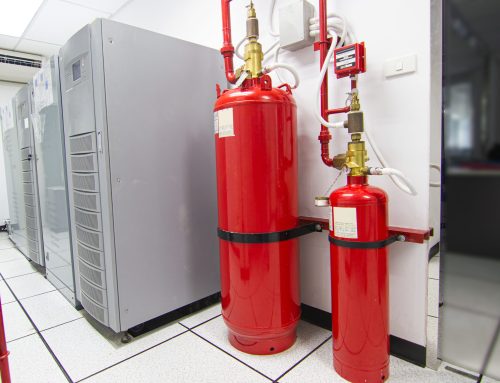Do you own a portable fire extinguisher?
Many homeowners have ways to detect smoke and fire in their homes, but no way to fight fire. And in your vehicle, there’s not even a detection device. A portable fire extinguisher adds a layer of protection and peace of mind when at home or on-the-go.
Fires can break out anywhere, at any time. Keeping a portable fire extinguisher handy may be the best way to defend yourself, your family, and your property against the dangers of small fires. Consider these three unexpected places you may not think to store a portable fire extinguisher.
In your bedroom
Most house fires occur at night, between the hours of 8 p.m. and 8 a.m. If you have a portable fire extinguisher in your bedroom, you may be able to escape if the fire is right outside your door. Having only one fire extinguisher in the home is useless if you’re trapped in your bedroom. A fire extinguisher kept in your bedroom may be the difference in being able to escape your room or entrapment.
A portable fire extinguisher kept in the bedroom is also helpful for fires that start in the bedroom. Though not as common as kitchen fires, it can happen. NFPA reports the bedroom as one of the leading origins in home structure fires started by smoking materials. And while we all know smoking indoors (especially in bed) is incredibly dangerous, smoking is still the leading cause of home fire deaths with one of every 31 home smoking material fires resulting in death.
Store your portable fire extinguisher in plain view. It should not be hidden away in a closet. Some people store them in a night stand or near the door. There are also fire extinguisher cabinets you can buy if keeping the extinguisher accessible is an issue. Tell children the location of the fire extinguisher and teach them to use it if they are old enough.

In your vehicle
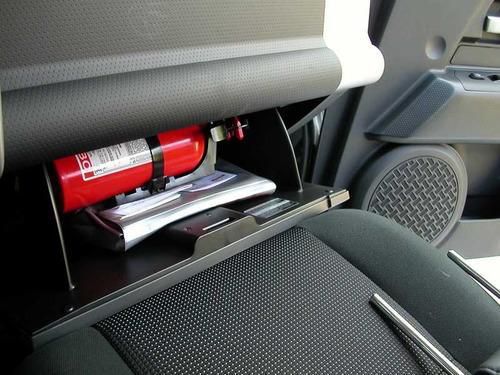
FEMA reports that each year, from 2014 to 2016, an estimated 171,500 highway vehicle fires occurred in the United States, resulting in an annual average of 345 deaths; 1,300 injuries; and $1.1 billion in property loss. These highway vehicle fires accounted for 13 percent of fires responded to by fire departments across the nation.
Mechanical failure was the leading factor contributing to the ignition of highway vehicles (45 percent). Insulation around electrical wiring and flammable liquids in the engine area were other top factors.
It’s important to know what to do should your vehicle catch fire. FEMA suggests the following steps:
- Get yourself and all others out of and safely away from the vehicle
- Never attempt to get back into the vehicle to retrieve personal property
- Call your fire department or 911
- Use a fire extinguisher at a safe distance from the vehicle
- Never open the hood or trunk if you suspect a fire under it, as air could cause the fire to enlarge
- Be aware of other vehicles on the roadway and never stand on an active roadway as there is the potential danger of being struck by another vehicle.
Choose a fire extinguisher rated for Class B and Class C fires. To store the fire extinguisher in your vehicle, strap it down in the truck of your vehicle. It should never be sitting unrestrained as it can move around the car in the case of an accident. And never try to extinguish a car fire that is burning out of control!
Outdoor living area
It’s commonly known that keeping a fire extinguisher in your kitchen is a smart idea. It may be a lesser known fact that it’s just as important to store a portable fire extinguisher on your patio or outdoor living area. NFPA notes that an exterior balcony or open porch were the leading area of origin for home smoking fires in 2012-2016.
Just think of all of the activities held in a typical outdoor living area: grilling, lighting candles, possibly even smoking. All of these heat sources can ignite into a dangerous fire. Another danger of an outdoor fire is the risk of fire spreading to the yard or to other yard debris that can be easily ignited. This is especially true during the summer months when conditions are drier.
Risks are even more heightened if you have portable heaters, wood burning stoves, or other heat sources used outdoors. A portable fire extinguisher kept near these heat sources is important in preventing fires caused by flammable objects being too close to fire.
Make sure to properly store your outdoor portable fire extinguisher to protect it against weather. One idea is to use an outdoor fire extinguisher cabinet. Another idea is to simply bring the fire extinguisher indoors in extreme heat or cold. The downfall of this option is forgetting to bring it back outside. However you store the extinguisher, ensure that it’s always accessible when enjoying your outdoor living area.
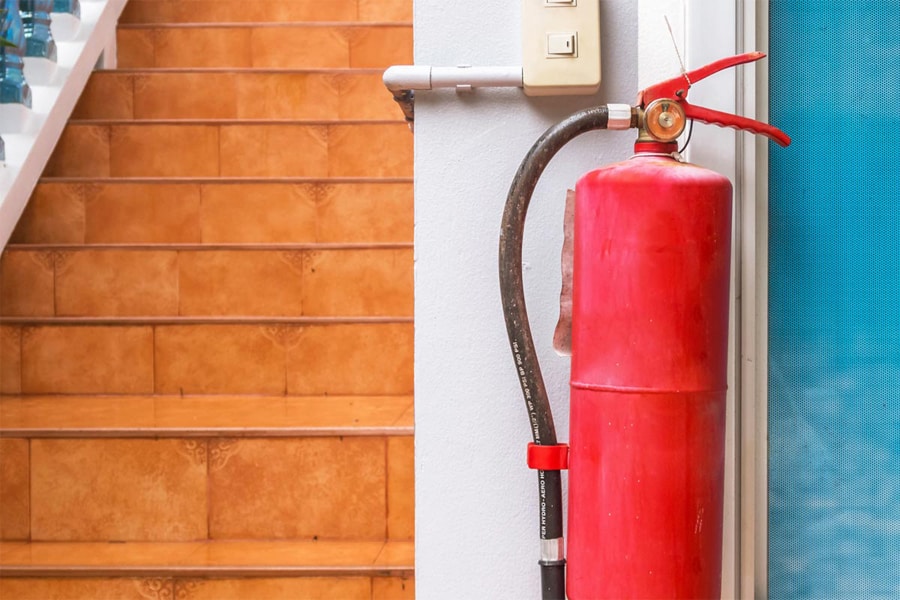
Using a portable fire extinguisher
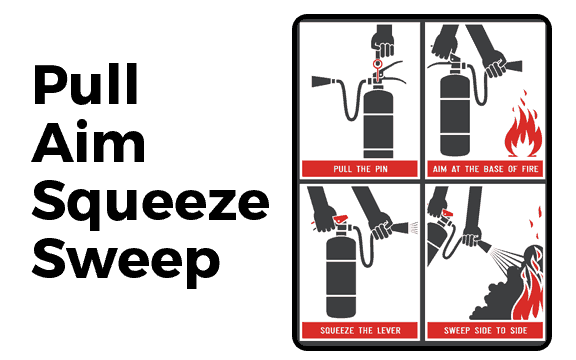
The NFPA suggests a multi-purpose extinguisher for home use that is large enough to put out a small fire, but not so heavy as to be difficult to handle. The portable fire extinguisher you choose should be approved for Classes A, B, and C fire hazards.
To operate a fire extinguisher, remember the word PASS:
- Pull the pin. Hold the extinguisher with the nozzle pointing away from you and release the locking mechanism.
- Aim low. Point the extinguisher at the base of the fire.
- Squeeze the lever slowly and evenly.
- Sweep the nozzle from side-to-side.
In addition to teaching anyone who lives in your home how to use a fire extinguisher, it’s important to have a fire emergency escape route. Take multiple measures to prevent a serious fire. Be sure to check smoke detector batteries. Smoke detectors should be placed on every floor of your house.
Maintaining your portable fire extinguisher
Portable fire extinguishers require annual service for businesses/commercial properties. Any portable extinguishers used in the home needs regular inspection as well.
To ensure your portable fire extinguisher is in proper working order, check the pressure gauge to see that the needle is the green area. This means it’s in working condition.
It’s also important to know when to replace a fire extinguisher. Replace or service any portable fire extinguisher if you notice:
- The hose or nozzle is cracked, ripped, or blocked with debris.
- The locking pin on the handle is missing or unsealed.
- The handle is wobbly or broken.
- The inspection sticker or hang tag, with a record of checkups and maintenance, is missing.
You will also need to replace your extinguisher if it’s ever been used.
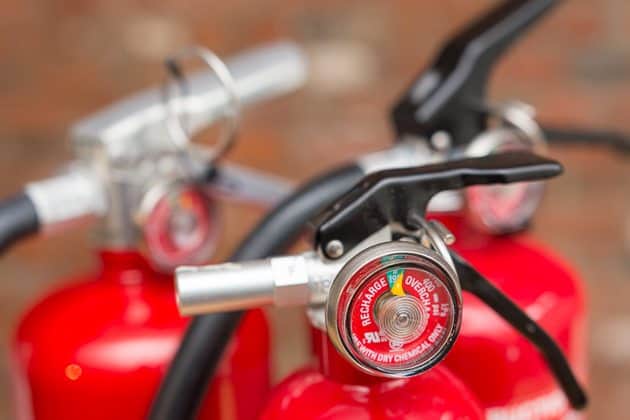
Fire Systems, Inc.
Fire Systems, Inc. is an Atlanta-based fire protection company specializing in a variety of fire protection services.
Commercial and government buildings are required to have regular inspections of all fire protection equipment. This includes fire sprinkler systems, fire extinguishers, fire alarm systems, and more.
Businesses should take all measures possible to prevent fire. This is why Fire Systems also offers employee training on how to use a fire extinguisher. This skill is imperative and will equip employees with potentially lifesaving skills.
Contact Fire Systems, Inc. today at 770-333-7979 or visit our website for more information.


